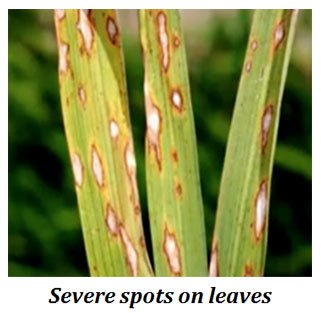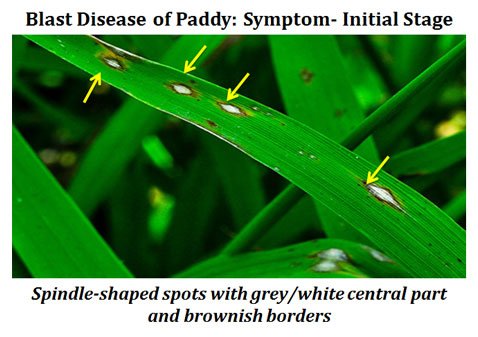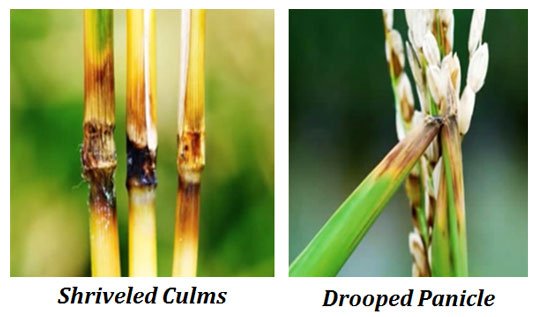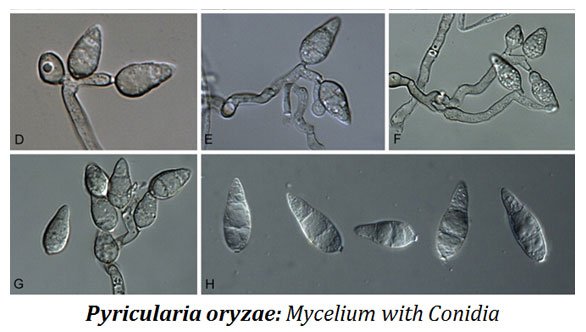Blast Disease of Rice : Rice is a cereal grain. It is the seeds of Oryza sativa (Asian rice) or Oryza glaberrima (African rice). Rice is the most extensively consumed staple food of human. It is the major staple food in Asia. Rice is the third highest agricultural commodity in worldwide production. The un-milled rice is known as “paddy“.
Blast Disease of Rice
Ø Blast disease is one of the most severe diseases affecting paddy.
Ø It is a fungal disease prevalent all over the world.
 Paddy / Rice
Paddy / Rice
Ø It is a major problem in rice production in countries like Japan, India, Taiwan and the USA.
Ø Blast disease is more severe in areas with high humidity and rainfall.
Ø Losses due to the disease may be up to 90% of the total corp.
Ø In India, the blast disease is more common in Southern parts, particularly coastal areas.
Symptoms
 Ø The blast is a foliage disease.
Ø The blast is a foliage disease.
Ø The symptoms also occur in other plant parts.
Ø Leaf blade, leaf sheath, petiole, rachis, stem etc. are affected by the disease.
Ø Brownish lesion and spots are formed on leaf blade, leaf sheath, culms and panicles.
Ø The spots are spindle-shaped with grey or white central part and brownish or reddish borders.
Ø The spots enlarge as the disease progress.
Ø Brown to black spots or rings is formed on the rachis of the mature inflorescence.
Ø Small brown or black spots on ear heads.
Ø Shriveled culms in severe cases.
Ø The culms were covered with fluffy mycelium of the pathogen.

Ø The occurrence of bluish patches on the neck or stem.
Ø If the infection occurred before the grain formation, panicles droops and no grain formation.
Ø If the infection occurred after grain formation, the grains become small, whitish and chaffy.
Ø In advanced stages of the disease, necrotic rotting of neck and falling of the ears occurs.
Ø Plants become stunted and untimely leads to the complete death of the plant.
Causal Organism
Ø Blast is a fungal infection
Ø Casual organism: Pyricularia oryzae
Ø Class: Deuteromycetes
Ø Several physiological strains of Pyricularia oryzae are present.
Ø These strains differ in their ability to infect different varieties of rice.
Ø The pathogen produces two toxins namely Pyricularin and Picolinic acid
Ø These toxins inhibit the growth of the plant.

Disease cycle
Ø The pathogen survives in the collateral hosts present in the fields.
Ø Favourable weather conditions promote the production of conidia.
Ø The conidia help in the rapid spread of the disease.
Control measures
Ø Foliar spray of fungicides is effective
Ø Application of Bordeaux mixture is also practice.
Ø Organo-meruric fungicides such as Hinosan and Blitox are also used.
Ø Spraying on the seeds, seedbed, tillers, and neck emerging state is done.
Ø Antibiotics such as Blastin and Blasticidin application are found to be effective.
Ø Seed treatment with organo-mercuric compounds reduces the fungal spore load on the surface of seeds.
Ø Field sanitation practice (removal of infected plants) can reduce the secondary spread of the disease.
Ø Destruction of alternate hosts in the field can be practiced.
Ø Use of resistant varieties is the best method to avoid the occurrence of the disease.
<<< Back to PLANT PATHOLOGY Notes
| You may also like... | ||
|---|---|---|
| NOTES | QUESTION BANK | COMPETITIVE EXAMS. |
| PPTs | UNIVERSITY EXAMS | DIFFERENCE BETWEEN.. |
| MCQs | PLUS ONE BIOLOGY | NEWS & JOBS |
| MOCK TESTS | PLUS TWO BIOLOGY | PRACTICAL |
You might also like…
@. Cassava Mosaic Disease: Symptoms & Control Measures
@. Enzymes in Plant-Parasite Interactions
@. Toxins in Plant-Parasite Interactions

Thank you so much for giving this type of notes